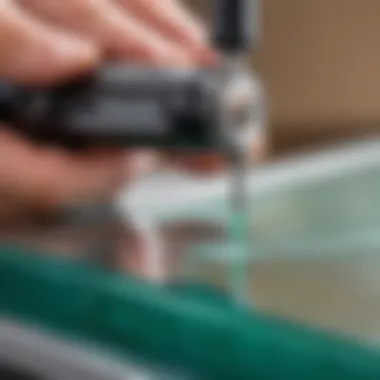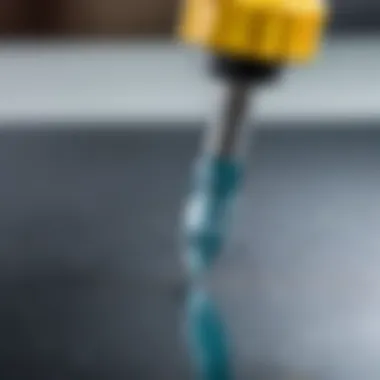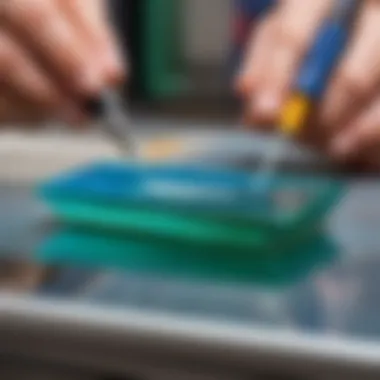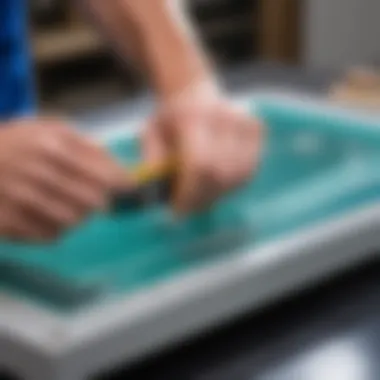Comparing Oil-Based and Diamond Glass Cutters


Intro
The world of glass cutting can be intricate, particularly when selecting the right tools. Among the key tools are oil-based and diamond glass cutters, each presenting unique capabilities and benefits tailored to different tasks. Understanding these differences is essential for both DIY enthusiasts and professionals. This article aims to offer a thorough evaluation of both types of cutters, aligning their strengths and drawbacks with specific application needs.
Проектирование и планирование
Prioritizing design and planning is crucial when approaching a glass project. The right approach can lead to enhanced outcomes and a more efficient use of tools and materials.
Как выбрать проект для DIY
Choosing the right project is the first step. Consider what you want to create with glass. Various projects, from simple window repairs to elaborate decorative items, require different skills and tools. Assess your experience and the complexity of the task at hand. Start with something manageable, allowing for gradual skill development.
Оценка времени и ресурсов
Evaluate how much time you can dedicate to the project. Some glass cutting tasks are more time-consuming than others. Factor in preparation time, the cutting process, and finishing efforts. Additionally, assess available resources like space for work, necessary tools, and of course, the glass material. Effective planning can save time and frustration later.
Glass Cutter Overview
Understanding the fundamental differences between oil-based and diamond glass cutters is pivotal.
- Oil-based cutters are affordable and suitable for straightforward tasks. They include a small reservoir of oil that lubricates the scoring tip, reducing friction when cutting glass.
- Diamond cutters, on the other hand, are made with a diamond-tipped scoring wheel. The strength and precision of a diamond tip allow for cleaner cuts, especially in thicker or tougher glass materials.
When choosing between these options, think about the project requirements.
A diamond cutter is often better for projects demanding precision, such as stained glass window installations.
Выбор материалов
Choosing the right materials is equally important. The type of glass you use will influence the choice of cutter. Different projects require specific glass types, and understanding this can lead to better results.
Типы материалов для различных проектов
Different glass types serve various purposes:
- Annealed Glass - commonly used for windows and picture frames.
- Laminated Glass - used for safety applications, often requiring precise cutting.
- Tempered Glass - thicker and stronger, ideal for tabletops, but harder to cut.
Советы по покупке и экономии
When purchasing materials, consider sourcing from local suppliers or directly from manufacturers to cut costs. Bulk purchases can also lead to savings. Additionally, inspect for any discounted offcuts that can be perfect for smaller projects. Always check local sources first to avoid unnecessary shipping costs, enhancing your project's affordability.
Careful consideration of both tools and materials will ensure that glass cutting becomes a rewarding venture. This guide sets the stage for effective and satisfying project execution.
Prelude to Glass Cutting Tools
When engaging in glass-related projects, understanding the tools available is vital. Glass cutting tools are not merely accessories; they are essential instruments that define the outcome of your work. A knowledgeable approach to selecting the correct glass cutter can lead to enhanced precision and satisfaction in your projects, whether you are a seasoned professional or a DIY enthusiast.
Overview of Glass Cutting Necessities
Glass cutting has evolved significantly, emphasizing the need for suitable tools. With the right glass cutter, projects can be completed neatly with minimal material waste. Oil-based and diamond cutters are the two primary categories in glass cutting tools. Understanding their unique functionalities and advantages is essential.
These tools operate on different principles. Oil-based glass cutters use a lubricant that facilitates smooth cuts, while diamond cutters rely on the hardness of diamond to perform precise incisions. Recognizing these differences aids in making informed decisions.
Additionally, practical aspects such as handling, weight, and maintenance play critical roles in the user experience. For instance, some may prefer the feel of a heavier cutter that provides stability, while others opt for lighter models that reduce fatigue during extended use. When choosing a glass cutter, a comprehensive assessment of these elements is imperative.
Importance of Choosing the Right Glass Cutter


Selecting the correct glass cutter transcends mere preference; it can determine the quality of the finished project. Each type of cutter offers distinct advantages depending on the task. For intricate designs or thicker glass, a diamond cutter may be the best choice due to its precision. In contrast, for broader cuts on thinner glass sheets, an oil-based cutter could suffice, providing a smoother finish.
Moreover, factors such as budget considerations, expected frequency of use, and available space for storage should influence your choice. Investing in a more durable or higher-quality cutter may be beneficial in the long term for frequent users. In contrast, occasional users might find less expensive options adequate.
Evaluating these aspects helps ensure a well-informed purchase that aligns with personal requirements and project goals. In summary, recognizing the vital importance of glass cutting tools leads to more efficient work processes and ultimately better outcomes.
Types of Glass Cutters
Understanding the different types of glass cutters is crucial for anyone embarking on glass-related projects. The choice between oil-based and diamond glass cutters can significantly impact the outcome of the project. Each type is suited for specific tasks, and their characteristics can influence both the quality of cuts and the overall user experience. Knowing these differences helps users make informed decisions based on their needs, cutting skill level, and the glass materials involved.
Oil-Based Glass Cutters
Oil-based glass cutters are popular for their ease of use and effectiveness in creating clean cuts. These tools typically feature a wheel made from tungsten carbide that slices through glass. The uniqueness of oil-based cutters lies in their integrated oil reservoir, which lubricates the cutting wheel as it works. This lubrication is vital as it reduces friction between the cutter and the glass, which helps to prolong the cutter's lifespan and produce smoother cuts.
Another significant feature is their availability. Oil-based cutters are widely accessible and are often used by DIY enthusiasts and professionals alike. They are effective on various thicknesses of glass, making them versatile for different projects.
Diamond Glass Cutters
Diamond glass cutters utilize a diamond-tipped wheel, which is renowned for its hardness and durability. The primary advantage of these cutters is their precision. The diamond tip allows for cleaner and more accurate cuts compared to oil-based cutters. This precision is especially valuable when working on detailed projects or thicker glass, where the risk of cracking is higher.
Additionally, diamond glass cutters often require less physical pressure to achieve good results. Therefore, users may find them easier to handle when executing complex cuts. However, the cost of diamond cutters is generally higher than oil-based ones. For serious glass crafters or professionals, this is an investment well worth making, as the performance and longevity can surpass that of oil-based options.
Key Features of Oil-Based Glass Cutters
Understanding the key features of oil-based glass cutters is critical for anyone involved in glasswork. These tools are known for their specific construction, mechanics, and cutting techniques that make them suitable for various applications. They present both advantages and considerations that affect usability and final outcomes.
Construction and Design
The construction of oil-based glass cutters typically features a robust and ergonomic design. Most cutters have a metal body and a pointed cutting wheel that scores the glass surface. This material gives durability and allows the cutter to withstand intense usage. An important design aspect is the grip; the handle usually is contoured for comfort during repetitive actions.
Because the handle is often made from rubber or plastic, it reduces vibrations during cutting. This design minimizes user fatigue, allowing for extended periods of use, especially in larger projects.
Oil Reservoir Mechanism
One defining characteristic of oil-based glass cutters is the oil reservoir mechanism. This reservoir holds a small amount of cutting oil, which lubricates the cutting wheel while scoring the glass. The oil ensures a smooth cut by reducing friction between the wheel and the glass surface. This lubrication also helps in preventing chipping, which can occur when the cutter drags on dry glass.
To effectively utilize this cutting oil, some models have a built-in trigger or lever that allows the user to control the flow. This is particularly advantageous in intricate cuts where precision is pivotal. Ultimately, the oil reservoir enhances the cutter's performance by prolonging both the cutter and the glass's lifespan.
Cutting Technique
The cutting technique used with oil-based glass cutters is crucial for achieving clean edges. Proper technique involves applying light pressure while pulling the cutter along the glass. The oil aids this process, allowing the cutter to glide smoothly. Users must focus on maintaining an even speed and pressure for optimal scoring depth.
For best results, it is recommended to score the glass in a single motion rather than back and forth. This technique reduces the chances of cracking or chipping the glass after the cut has been made. Following the scoring, a gentle snap can separate the glass along the scored line, creating a clean break.
In summary, the key features of oil-based glass cutters, from construction and oil reservoir mechanics to cutting techniques, play a vital role in their effectiveness. These tools cater well to projects that demand precision and clean cuts.
Key Features of Diamond Glass Cutters
Diamond glass cutters are recognized for their unique characteristics that contribute to their efficiency and effectiveness in glass cutting projects. Understanding these features is crucial, especially when choosing the right tool for specific tasks. Let's analyze key aspects, starting with material composition.
Material Composition
The core of a diamond glass cutter lies in its material construction. Typically, these tools are equipped with a diamond-tipped cutting wheel, which is essential for achieving precise cuts. Diamonds are one of the hardest materials known, allowing these cutters to slice through glass with minimal effort. Unlike oil-based cutters that rely on a scoring mechanism, diamond cutters exploit their hardness to create clean cuts. Additionally, the tip is often made from industrial-grade diamonds, which enhances the longevity and performance of the cutter. Importantly, the design may also include a metal body that provides durability and stability during use.
Durability Analysis


Durability is another significant feature of diamond glass cutters. Given their robust construction, these tools tend to withstand harsh conditions and heavy use. The diamond-tipped wheel is resistant to wear, ensuring that users do not have to replace the cutting wheel as frequently as those used in oil-based cutters. Many users report that a high-quality diamond cutter can last for years with proper maintenance. This means that in the long run, diamond glass cutters can be more cost-effective, as they do not need constant replacements. However, the initial cost can be higher than oil-based options, making it essential to evaluate usage frequency when deciding on a purchase.
Precision Cutting Capability
A defining characteristic of diamond glass cutters is their precision cutting capability. With the sharp nature of the diamond tip, users can create intricate cuts with accuracy. This is particularly valuable for projects requiring detailed designs or custom shapes. The precise nature of these tools minimizes the risk of chips or cracks occurring during the cutting process. Many professionals prefer diamond cutters for this reason, as they can work on delicate pieces without compromising quality. The cutting technique involves a straightforward motion over the glass surface, which translates to clean and straight lines.
"When it comes to precision, diamond cutters stand out, making them the preferred choice for serious craftsmen." In summary, the key features of diamond glass cutters underscore their strength, durability, and cutting precision, making them a vital tool for those engaged in glass work, whether for repairs, design, or construction tasks.
Comparative Analysis of Oil-Based and Diamond Cutters
In the realm of glass cutting, understanding the strengths and weaknesses of various tools is crucial. Both oil-based and diamond cutters offer unique features that appeal to different user preferences and project requirements. This section will dissect these two types of cutters with a focus on efficiency, cost-effectiveness, and maintenance. By presenting a clear comparative analysis, readers can make informed decisions when selecting the right glass cutter for their tasks.
Efficiency in Cutting Glass
Efficiency refers to the ability to complete cutting tasks quickly and effectively. In terms of oil-based cutters, these tools are often favored for their easy handling and smooth operation. The oil allows for a steady flow during cutting, which can result in cleaner lines with less risk of chipping. Conversely, diamond cutters are renowned for their ability to penetrate tougher glass surfaces. This makes them preferred for projects involving thicker or more durable glass types.
When assessing efficiency, consider the glass material and thickness. Oil-based cutters may perform well on standard glass sheets, while diamond cutters excel when dealing with glass that demands greater precision and strength. User experience can also influence perceived efficiency, with some craftsmen claiming that a skilled operator can achieve remarkable results with either tool.
Cost-Effectiveness
The aspect of cost-effectiveness is a key consideration in any tool choice. Oil-based glass cutters typically cost less upfront compared to diamond cutters. The initial investment is appealing for hobbyists or those engaging in occasional glass cutting. However, the longevity and durability of diamond cutters present a compelling argument for their higher price point.
Investing in a diamond cutter can yield significant savings in the long run due to its extended lifespan and minimal need for replacement. For professionals or those frequently engaged in glass cutting tasks, a diamond cutter may prove more cost-efficient overall. Therefore, the choice between these types may hinge on individual product usage and budget constraints.
Maintenance and Longevity
Maintenance practices differ for oil-based and diamond cutters. Oil-based cutters require regular refills of oil to operate efficiently. This can be an additional effort but is usually a straightforward process. On the other hand, most diamond cutters are designed to withstand rigorous use without the need for extensive upkeep. They tend to be more robust, allowing users to focus on their projects rather than worry about tool maintenance.
Longevity is another critical factor. A well-maintained oil-based cutter can last several years, but its lifespan may be shorter when used on tougher glass materials. Diamond cutters, with their hard surfaces, often last longer, providing reliable service over time.
Practical Applications for Oil-Based Cutters
Oil-based glass cutters have specific strengths that make them suitable for various glass cutting tasks. Understanding these practical applications can improve the efficiency and outcomes of glass projects. This section will explore ideal usage scenarios and provide user recommendations for those considering oil-based cutters.
Ideal Usage Scenarios
Oil-based cutters excel in situations that require precision and smooth operation. They are best used for tasks such as:
- Creating intricate designs: Artists and designers often choose oil-based cutters for detailed work where fine control is needed.
- Thin glass sheets: The lubricant helps in cutting fragile materials without causing breakage.
- Long cuts: For straight cuts over larger glass surfaces, the oil maintains the cutter’s performance, reducing the chances of breaking the glass.
- Repetitive cuts: If a project involves multiple similar cuts, oil-based cutters can deliver consistent results with less friction.
- Repair work: When working with stained or decorative glass, the lubrication assists in obtaining clean edges, essential for seamless repairs.
These scenarios showcase the versatility of oil-based cutters and highlight their abilities under various project requirements.
User Recommendations
When using oil-based glass cutters, certain recommendations can enhance the cutting experience:
- Select the right oil: Using a high-quality cutting oil can improve performance. Users should look for oils specifically designed for glass cutting.
- Maintenance matters: Regularly refill the oil reservoir to ensure consistent lubrication. This aids in prolonging the life of the cutter and achieves better cuts.
- Practice makes perfect: New users should practice on scrap glass to refine their technique before working on a final piece. This ensures proficiency and confidence.
- Sharpness checks: Regularly inspect the cutting wheel for wear. A dull wheel can lead to uneven cuts and causes frustration.
- Safety first: Always wear protective eyewear to safeguard against glass shards, no matter the project type.
Adhering to these recommendations can lead to better results and enhance the user's experience with oil-based glass cutters. Ultimately, understanding the practical applications alongside the right choices in oil and maintenance can greatly influence the success of glass cutting endeavors.
Practical Applications for Diamond Cutters
When it comes to glass cutting, understanding the practical applications for diamond cutters is vital. These tools are not just for hobbyists but are widely used in various professional settings. Their construction and durability make them suitable for a wide range of projects, from intricate designs to large-scale installations. Users seeking to achieve precision and efficiency often turn to diamond cutters due to their versatility.
Versatile Project Suitability


Diamond glass cutters are especially valued for their ability to handle different types of glass. Whether you are working with thin glass sheets for picture frames or thicker glass for windows, these cutters can adapt to diverse tasks. This capacity stems from the sharpness of the diamond blade, which allows for clean cuts without chipping the edges.
In renovation projects, diamond cutters excel in jobs such as cutting glass tiles or mirrors. They can create precise shapes needed for custom installations. The high quality of the cut also means less need for post-processing work.
Some elements that enhance their versatility include:
- Quality of Cuts: Diamond cutters produce noticeably cleaner edges, making them ideal for visible surfaces.
- Range of Thickness: They can effectively cut glass of varying thickness, expanding their usefulness in many applications.
- User-Friendly Design: Many diamond cutters come with ergonomic grips and easy-to-follow guides that facilitate usage, even for less experienced individuals.
Feedback from Experienced Users
Feedback from those who have extensively used diamond glass cutters highlights their benefits in real-world applications. Many users, including interior designers and builders, appreciate how these tools enhance the precision of their projects.
One common sentiment among experienced users is the reliability of diamond cutters. Many mention that after using an oil-based cutter, switching to diamond significantly improved their cutting accuracy. Moreover, the durability of the diamond blade often means longer periods between replacements, making them cost-effective in the long run.
"Switching to a diamond cutter made all the difference in my work. The clean cuts meant less time wasted on finishing edges and more time on creating beautiful installations."
Some feedback points include:
- Value for Money: Users often note that while diamond cutters can be priced higher initially, the longevity and performance justify the investment.
- User Satisfaction: Many find that the learning curve is minimal, resulting in high satisfaction quickly.
- Professional Recommendations: It is common for users to recommend diamond cutters to peers, indicating a strong trust in their capabilities.
Safety Considerations in Glass Cutting
Understanding safety considerations in glass cutting is crucial, not only to prevent personal injury but also to ensure the successful completion of your project. Working with glass can be hazardous if proper precautions are not taken. Sharp edges and breakage pose significant risks, making it essential to implement safety measures. This section will highlight the necessary precautions and equipment needed to create a safe work environment.
Personal Protective Equipment
When attempting to cut glass, using appropriate personal protective equipment (PPE) is non-negotiable. The right gear protects against potential injuries that may occur from glass shards or mishaps during cutting.
Some essential items of PPE include:
- Safety Glasses: Protect your eyes from flying glass particles. Choose impact-resistant models for maximum safety.
- Cut-Resistant Gloves: These prevent cuts or scrapes while handling broken or sharp edges.
- Dust Masks: If cutting creates a significant amount of dust, wearing a dust mask will help in reducing inhalation risks.
- Steel-Toe Boots: Wearing closed-toe shoes with steel reinforcement can prevent foot injuries from dropped materials.
Using these items can significantly reduce the risk of serious injuries while working.
Best Practices for Safe Cutting
Best practices play an important role in ensuring safety during glass cutting. By following recommended guidelines, you can minimize hazards and complete your tasks efficiently. Here are some of the top practices:
- Prepare the Workspace: Ensure your work area is clean and well-lit. Eliminate any clutter that may cause accidents.
- Secure the Glass: Use clamps or a sturdy surface to stabilize the glass while cutting. This prevents slipping and ensures straight, safe cuts.
- Use the Right Tools: Employ the correct type of glass cutter suited for your specific task. Familiarize yourself with its operation.
- Follow Cutting Techniques: Proper cutting techniques should be practiced. Steady, even pressure is crucial for achieving clean cuts without excessive force.
- Handle with Care: After cutting, carefully manage the glass pieces to avoid accidents. Dispose of broken shards properly to prevent injury.
Following these practices not only enhances safety but also improves cutting efficiency, ultimately leading to better project results.
Epilogue: Selecting the Right Glass Cutter
Choosing the appropriate glass cutter is essential for effective glass work. It can greatly influence the quality of cuts and the ease of handling, aligning closely with the project needs. In this article, we have unearthed the distinct attributes of oil-based and diamond cutters. Each type has its own strengths and weaknesses based on various factors like material compatibility, precision, and user skill level.
This discussion places emphasis on the technical differences between the cutters and their respective applications. The right glass cutter not only enhances performance but also promotes safety during projects. Therefore, understanding the unique capabilities of each tool will lead to better outcomes for DIY enthusiasts, interior designers, and builders alike.
Summarizing Key Points
There are several critical elements to summarize regarding oil-based and diamond glass cutters:
- Construction: Oil-based cutters are designed with a roller or wheel that uses oil to lubricate while cutting. This feature enhances smoothness and reduces friction. Diamond cutters, on the other hand, have a hardened tip that allows for cleaner marks on the glass surface.
- Uses: Oil-based cutters are generally easier to handle and might be more suitable for novices. They are ideal for small projects and finer details. However, diamond cutters are preferred for projects requiring high precision, like custom glass installations.
- Cost-Effectiveness: Oil-based cutters tend to be less expensive, making them appealing for DIY repairs. Diamond cutters require higher investment but are longer-lasting if maintained correctly.
- Maintenance: Oil-based cutters need regular oil refills and periodic cleaning. Diamond cutters require proper handling to maintain the cutting edge but are less maintenance-intensive overall.
Ultimately, the choice of glass cutter should align with the specific requirements of the task at hand.
Final Recommendations
When selecting a glass cutter, keep the following considerations in mind:
- Skill Level: Beginners might find oil-based glass cutters more approachable. Practice helps in understanding their functionality better.
- Project Requirements: For tasks that demand high precision, such as intricate designs or large glass sheets, diamond cutters are more beneficial.
- Budget: If cost is a major factor, consider an oil-based cutter for initial projects. For frequent or professional tasks, investing in a diamond cutter proves effective in the long run.
- User Recommendations: Seek feedback from experienced users to understand what works best for different scenarios.







